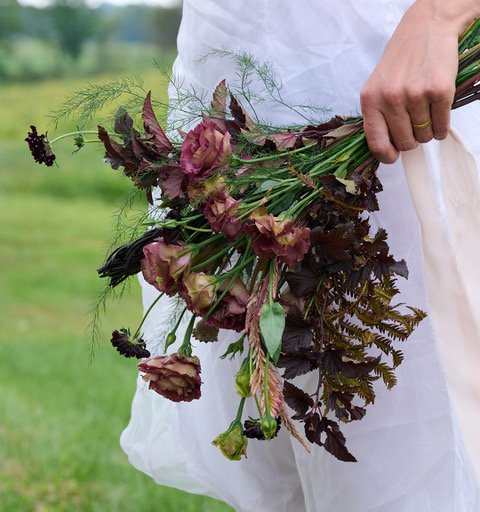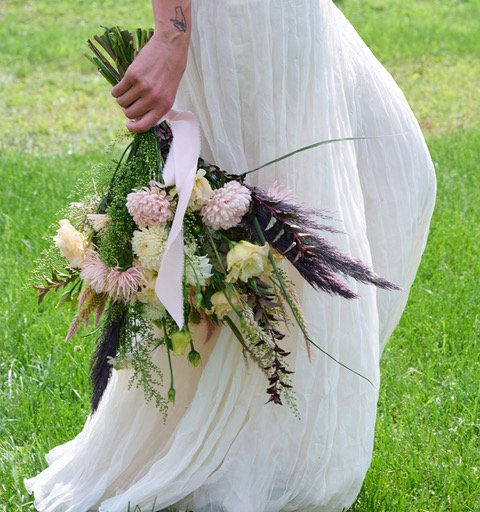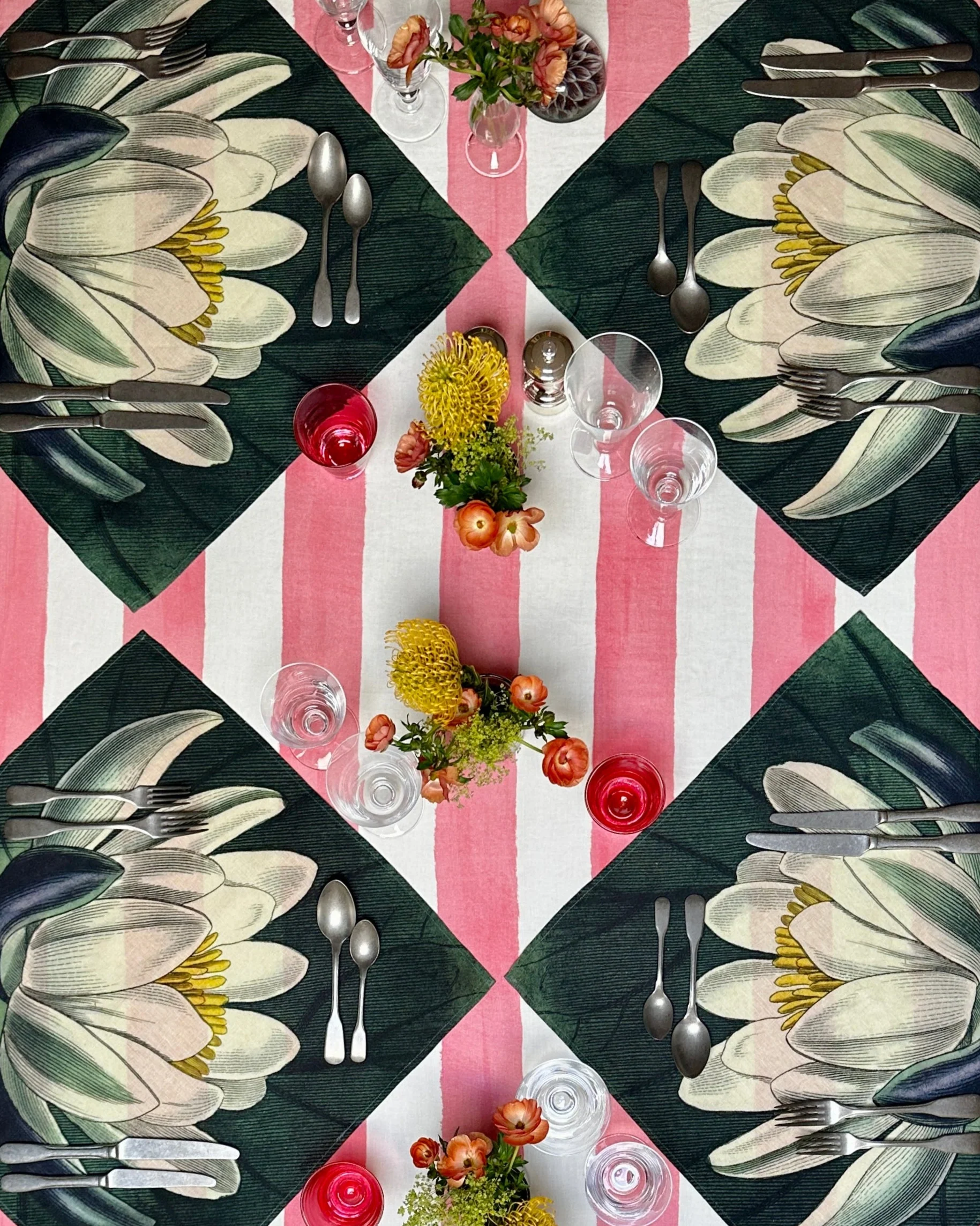Where the Wild Things Bloom
- Ava Vitiello

- Apr 15
- 9 min read
Updated: Apr 21
How a Fashion Creative Director Found Her Rhythm with Specialty Flower Farming in Upstate NY
Tucked away on a rural country road in Ephratah, New York, you will find Mud Road Farm.
Greeted by her two boisterous Australian Shepherds, Susan Conway welcomes me into her home. Any noise from the outside world instantly fades away and I am finally present.
I’ve known Susan and her family since I was a child. My siblings and I went to school with her children, and we grew up with fond memories of visiting their farm. Summers splashing around in the creek behind their fields, retreating to the cozy farmhouse (originally built in 1838 and rebuilt in 1942), being surrounded by their vast farmlands with horses, chickens, garlic, and the abundant nature of Upstate New York. It’s undeniably a special place.
It’s a rainy April afternoon and I am met with a piping cup of hibiscus tea (both of our favorites), sweetened with a bit of honey from her neighbor’s bees. The fire is burning and her plush chocolate velvet couch is calling my name. But, first, we check on her seeds that have been germinating.
Susan spent her teenage years as a ballerina in New York City before venturing into branding and creative direction for acclaimed fashion houses and publications including Marc Jacobs and Details magazine. I can’t help but envy the life she has lived.
Each year, when deciding on a variety of flowers to grow and planning her garden layout, Susan turns to her creative background for inspiration, seeking ideas from fashion magazines, specific color palates, fabrics, and nature.
Bringing this creative energy comes naturally to her farming methods. Everything at Mud Road Farm is organic, without the use of pesticides or chemicals. Her husband, Johnny, spearheads the agricultural aspects of the farm and they are easily a perfect match.
Ava Vitiello: Can you explain a bit about your background?
Susan Conway: I got a scholarship with Joffrey when I was 13, so throughout high school, I went into New York City six days a week all year round. Then, I went to Parsons School of Design for graphic design and I started in promotion for various magazines including House & Garden, GQ, and Details magazine. My next job was working for Marc Jacobs who took over as an art director for Perry Ellis. Then, I ended up at Arnell Group which did the iconic Donna Karan New York City black-and-white skyline campaign. I was a creative director with fashion brands from Ungaro to Loewe and I loved it. When I had my son Declan, the farm was calling me and we had always dreamed of living here. So, I left my job and we moved. It wasn't an easy transition, I missed my jet-setting life, flying on the Concorde and staying at The Pierre.

AV: What led you to farming?
SC: We had already been farming when we were coming up here just for the summers. We took off August and would be up here–we had a huge garden and that's when we started growing garlic. We had too many vegetables, so I would bring them up to the city for my friends. I made a promotional piece for Dean & DeLuca and they bought my garlic, just all this crazy stuff that we used to do. When the kids came into the picture we did a little farmer’s market up here and started going to garlic festivals in Saugerties and Southern Vermont. We haven't done a garlic festival in 15 years, but we have a huge following from those days. So, we're still selling literally 28 years later to some of the same people and their friends, mostly all by word of mouth.
The kids were raised with us growing most of what we ate in the garden, we had chickens and sheep which we ate too. We sort of did a really big farm thing because my kids were here with me. We then continued with garlic and I did event planning and weddings while my kids were in school. That led me to grow my own flowers. I’m not really sure what it was that made me decide to be a flower farmer. I did take a class in flower farming and just went for it. My background has a huge influence on how I approach things. I am a very visual person, so the way my garden is laid out, the way my shop looks, you know, everything has to be just a certain way.
Ava: So, farming isn’t something you grew up doing?
Susan: No. I always loved flowers. We had a small garden in our yard that I would tend to. I always loved being in the dirt somehow, but if you had told me then that I would be a farmer I would not have believed you. I feel super connected when I’m in the dirt–I see the bees, I see birds flying around–it’s just a really great place to be. We work completely organic and sustainable, so keeping the whole ecosystem of our farm is important.
-
Ava: What does the seasonality of your work look like?
Susan: The process starts with sewing seeds now and planting in April or May and having flowers in June through October. I do make fall wreaths and then I get into a Christmas thing doing garlands and wreaths. By the time it’s Christmas there’s a bit of a lull, but come January and February I have to start ordering seeds and planning out my gardens. There’s never really any downtime for a flower farmer.
Ava: Which flowers do you consistently use each year and which are your favorites?
Susan: I always have dahlias. They are very labor intensive, you have to dig them up and store them over the winter, but they are an exquisite flower and they come in every shape and every color. I love China Aster. They come in the most amazing colors, like these dirty pinks and lavendery purples. Their shapes look like Dr. Seuss flowers, I just absolutely love them. The thrill of seeing the first flower that pops up and opens after all that time. I also love grasses, any kind of grass. Everything has a different texture, different shape.
I’m really picking by color, I have a very specific palate and I tend to create with a very monochromatic color scheme. I love a zinnia which are super cheerful and happy. They come in the most intense colors: flaming red, hot pink–they’re just really hearty and beautiful.
Ava: Where do you find inspiration for your flower garden?
Susan: I am always drawn to something that is different. I don’t really love sunflowers; they’re too big, too heavy, but if you find that chocolate deep brown sunflower and put that with blush pink flowers it’s beautiful.
I get inspiration from fashion magazines for color and texture. Fashion has a huge influence on me from my background working in the industry. As a creative director, I love to go to New York City and just find one great, inspiring person–whether it’s the shape of the clothes they’re wearing or the way they have their hair or a piece of jewelry–I’m inspired by those things. Even interior and home magazines. I also get a huge inspiration from being on this farm and walking through my woods. In the winter, when you see that first green fern poking through the snow and everything else is grey, it’s just incredible. Discovering things in the woods that I haven't seen before is so special.
Ava: What is the timeline and how do you actually grow a flower from a seed?
Susan: You have to plan backward from when you start your seeds to when you can plant them out. Zinnias go in four weeks after the last frost. You have to have a really good seed starting mix and it has to be moist enough, like it clumps in your hand but the water isn't dripping out and you can put them in an egg carton or a seed tray like I have. Some of these seeds are smaller than a pinhead. Some have different needs, but water and moisture are the most important things. You have to watch that they aren’t getting dry, but you don’t want the water sitting in there. On a seed packet, it will show you exactly how and when to start. I do pay attention to the germination time too. When you’re doing this at home, the best thing to do is get a grow light because you really want light about two inches above your soil. As it grows you can put the light up. If it’s growing towards a window it’s going to grow up towards the light and get really leggy. So there is a little bit of a science to starting seeds. Every day I’m in there checking if they’re getting dry. After a couple of weeks, if things start popping out, I will start to use fish fertilizer and pour it into the tray to soak up.
Ava: What has been your biggest challenge?
Susan: I have a lot of challenges. Some of those trays are only half full. Whatever happened to them, I won’t know. I’m trying to start one of my favorite flowers, pincushion scabiosa, and I just cannot get it to germinate this year. I don’t know why, I did fine last year. The high tunnel is a challenge, as it extends my season. I didn't go to Ag school, I didn’t go to farmer school, so I’m trying to learn those things by trial and error or doing some research. Everybody is like: “Just go, you’re going to have a lot of failure, but keep doing it again.” It was so hot last year and there was a lot of bug infestation in my dahlias that made them not bloom fully either. Mother Nature is challenging.
-
Ava: When is the garlic ready to be harvested? What are a few different varieties of garlic you grow?
Susan: In June, we’re scaping. We harvest July through the beginning of August because certain varieties are ready before others. Then, we’re usually selling in September. We grow German Red, Bulgarian, Mohawk, Porcelain, Marino, and Italian Red. We've been growing Italian Red, a softneck variety, for a couple of years. Last year they came up so beautifully. It also works well for the braids and we found that it is the most amazing keeper. It’s incredible.
The really great thing for me, too, is that Johnny handles a huge part of everything that we do. I’ll do soil tests but he’ll tell me what it needs. He manages the soil for the farm, he cover crops, and takes care of irrigation. There’s just no way it could be done without him, he has a huge knowledge of that stuff. He runs all of the irrigation for me. It is a total team, there’s no way I could do it on my own.
Ava: When creating arrangements, how do you curate a selection of flowers?
Susan: My bouquets are completely designed. My colors are usually monochromatic with a pop of contrast. Some other farmers follow a formula, and I just don’t do that. No two bouquets are the same. Even the way my booth looks at the markets, I don’t have the pop-up, I bring furniture, and I schlep all of this stuff, but I can’t work in a space that is not totally feng shui. Anybody who has come by the booth appreciates it!
Ava: What is your favorite part of this job?
Susan: I love arranging, whether that’s making bouquets for the farmers market or making flowers for a wedding or somebody’s dinner party–I like that creative process. There’s magic in everything. When I see these seeds, then these little tiny things coming up, I am just so thrilled. I mean, it’s a miracle. This morning, I went into the high tunnel to check on my seedlings and I had my first three beautiful daffodils blooming in there. It’s just amazing to me and the most beautiful thing. You plant these little tiny seeds and then have these abundant gardens. It is unbelievable what can happen in five months. Even in the decaying stage, like the ostrich ferns dying in the front of my house, there’s always beauty.
-
Ava: Do you have any tips for someone making flower arrangements at home?
Susan: Start small and buy things that you love to look at, whatever color or shape. Go through the entire creative process. Every Monday, make a bouquet for yourself or bring one to a friend. It could be one flower that is perfect. That creative practice is important. Take a minute amidst all of the chaos to be creative.
Susan’s SecondsPls Picks
"Well, I like going to Europe. Johnny and I ended up in his really small town in Italy called Bevagna. There was this little farmer’s market going on and the town had a beautiful square. We had an interaction in this little restaurant where it was like being in this woman’s living room–filled with posters and artworks–her name was Suzie and we just became best friends and want to go back there."

"I do need to go to New York City every once in a while just to see people and culture and clothing. Go into Prada, touch all the fabric, look at the hand sewing. To me, that’s art and it’s just something I need to do for myself. There’s another small shop called John Derian. He started years ago and does collages on glassware. He travels all over the world and finds the most beautiful things. The most incredible quilts, plates, dog leashes, Christmas ornaments, I don’t know where he finds this stuff but there is not a single thing in that store I wouldn’t want. Whenever I’m in the city I have to go there. Going to a museum is always inspiring, too."
"And, here. The farm is really special. I live in utopia. I am so lucky. This is a super magical place, I’m really content here."













































































Comments